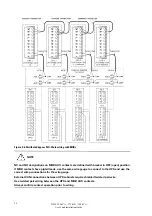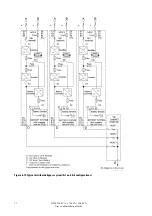
71
6.4 Multiple UPS distributed bypass system
Distributed bypass parallel operation extends the normal operation of Eaton 9395 UPSs by offering
increased capacity and/or redundant capability.
The output of the system is normally supplied by Uninterruptible Power Modules (UPMs) contained in
each UPS. Multiple UPMs are connected with their outputs in parallel (tied together) to provide a load
level greater than the rating of one UPM, for redundancy, or both. The paralleled UPMs supply the
output load with protected power as long as the load does not exceed the combined rating of the
paralleled UPMs.
The power system is redundant as long as one of the UPMs can be disconnected from the output bus
and the remaining UPMs can continue to supply power to the load without exceeding their ratings.
When the load is being supplied by the UPMs, the system output bus is continuously monitored for an
overvoltage or undervoltage condition. If an out of limits condition is detected, the paralleled UPSs
transfer the load to bypass using the UPS static switches.
Communication is required between the UPSs for system metering and mode control. System level
communication and control are accomplished using a Controller Area Network (CAN). A pull chain
signal in each UPS, connected to the other UPSs in parallel and tied to the bypass Status Relay in each
UPS, is used for a secondary communication path. This arrangement ensures bypass control even if
the CAN bus is lost.
The system is paralleled for (N+1) redundancy, as long as there is always one or more UPMs online
than required to support the load. The system is paralleled for capacity if all UPMs in a system are
required to support the load.
6.4.1 Multiple UPS parallel system modes
Similar to the single UPS system, the Eaton 9395 UPS parallel system supports a critical load in five
different modes of operation. The standard operation modes are:
NOTE
The Variable Module Management System and Energy Saver System modes are mutually
exclusive.
•
In Normal mode, the paralleled UPMs supply the critical load with clean, filtered power. Each UPM
battery charger also provides charging current for the battery if needed.
•
In Energy Saver System (ESS) mode, commercial AC power is supplied directly to the critical load
through the continuous static switch and transfers automatically to Normal mode if an abnormal
condition is detected. ESS mode in a parallel system operates the same as it does in a single UPS
system (see Section 6.2.5).
•
In Variable Module Management System (VMMS) mode, the UPS operates as a traditional double-
conversion UPS, but selectively shifts the load to fewer UPMs to increase the efficiency of the
UPS. VMMS mode operates the same as it does in a single UPS system (see Section 6.2.4).
•
In Bypass mode, the critical load is directly supported by utility power through the bypass circuits
in each UPS.
•
In Battery mode, the battery provides DC power, which maintains UPM operation. The UPM
batteries support the critical load.
9395P 250 kVA / 275 kVA / 300 kVA
User’s and Installation Guide
Summary of Contents for Power Xpert 9395P 250 kVA
Page 1: ...User s and Installation Guide Power Xpert 9395P UPS 250 kVA 275 kVA 300 kVA...
Page 2: ......
Page 3: ...Power Xpert 9395P UPS 250 kVA 275 kVA 300 kVA User s and Installation Guide...
Page 168: ......
Page 169: ......
Page 170: ...614 01919 00...
















































